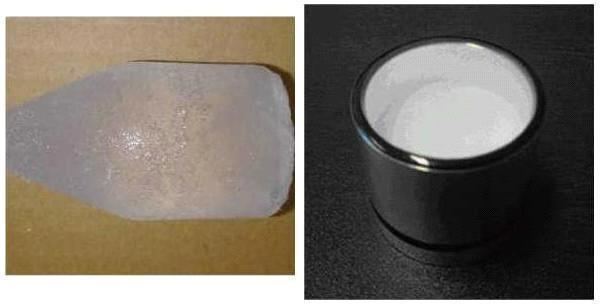Formula LaBr3 Molar mass 378.62 g/mol Boiling point 1,577 °C | Density 5.06 g/cm³ Melting point 783 °C Appearance white solid, hygroscopic | |
 | ||
Lanthanum(III) bromide (LaBr3) is an inorganic halide salt of lanthanum. When pure, it is a colorless white powder. The single crystals of LaBr3 are hexagonal crystals with melting point of 783 °C. It is highly hygroscopic and water-soluble. There are several hydrates, La3Br·X H2O, of the salt also known. It is often used as a source of lanthanum in chemical synthesis, and is being evaluated for use as a scintillation material in certain applications.
Contents
Uses
Cerium activated lanthanum bromide is the recent inorganic scintillator which has a combination of high light yield and the best energy resolution.
Lanthanum bromide scintillation detector
Recent advances in scintillator material have resulted in the development of cerium activated lanthanum bromide (LaBr3) detectors. LaBr3 was discovered in 2001. These detectors offer improved energy resolution, fast emission and excellent temperature and linearity characteristics. Typical energy resolution at 662 keV is 3% as compared to sodium iodide detectors at 7%. The improved resolution is due to a photoelectron yield that is 160% greater than is achieved with sodium iodide. Another advantage of LaBr3 is the nearly flat photo emission over a 70 °C temperature range (~1% change in light output).
Today LaBr3 detectors are offered with bialkali photomultiplier tubes (PMT) that can be two inches in diameter and 10 or more inches long . However, miniature packaging can be obtained by the use of a silicon drift detector (SDD). These UV enhanced diodes provide excellent wavelength matching to the 380 nm emission of LaBr3. A paper presented at the 2005 IEEE Nuclear Science Symposium shows that the SDD has a higher quantum efficiency over the PMT. Moreover, the SDD is not as sensitive to temperature and bias drift. The reported spectroscopy performance of the SDD configuration resulted in a 2.8% energy resolution at 662 keV for the detector sizes considered.
LaBr3 introduces an enhanced set of capabilities to a range of gamma spectroscopy radioisotope detection and identification systems used in the homeland security market. Isotope identification utilizes several techniques (known as algorithms) which rely on the detector’s ability to discriminate peaks. The improvements in resolution allow more accurate peak discrimination in ranges where isotopes often have many overlapping peaks. This leads to better isotope classification. Screening of all types (pedestrians, cargo, conveyor belts, shipping containers, vehicles, etc.) often requires accurate isotopic identification to differentiate concerning materials from non-concerning materials (medical isotopes in patients, naturally occurring radioactive materials, etc.) Heavy R&D and deployment of instruments utilizing LaBr3 is expected in the upcoming years. (List of companies who manufacture commercial off-the-shelf Radiation Isotope Identifiers for Homeland Security: Canberra Industries, ORTEC, Berkeley Nucleonics, spectra sample and spectroscopy example])
